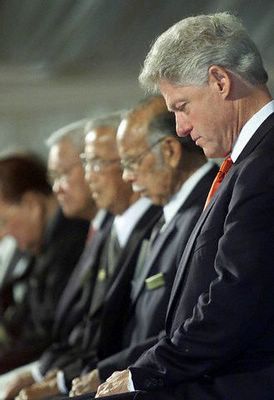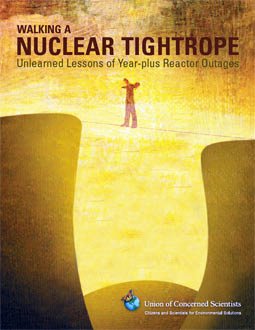 October 8, 2006. 0130z. This is a Water Vapor satellite of the North and West hemisphere of Earth by UNISYS. It is North America. There is currently a vortex over North and South Carolina. There is absolutely no doubt Earth is in a spiral to a hostile biotic troposphere due to CO2 emissions. The USA is the greatest contributor to Greenhouse Gases. Bar none. There are other countries not YET a part of Kyoto that should voluntarily commit, such as China, but they are considered a third world country and have the benefit of benevolent and wealthy nations to allow growth over conservation. China uses all forms of energy, including wind power. They try and through those efforts are already identifying the need to curb their emissions and seek alternative sources of energy.
October 8, 2006. 0130z. This is a Water Vapor satellite of the North and West hemisphere of Earth by UNISYS. It is North America. There is currently a vortex over North and South Carolina. There is absolutely no doubt Earth is in a spiral to a hostile biotic troposphere due to CO2 emissions. The USA is the greatest contributor to Greenhouse Gases. Bar none. There are other countries not YET a part of Kyoto that should voluntarily commit, such as China, but they are considered a third world country and have the benefit of benevolent and wealthy nations to allow growth over conservation. China uses all forms of energy, including wind power. They try and through those efforts are already identifying the need to curb their emissions and seek alternative sources of energy. 
 A picture of William Jefferson Clinton in 2000 during a ceremony awarding Congressional Metals of Honor (Click on)The 'study' mentioned above of the CO2 emissions was conducted in 1999 and published in 2000. The 'president' mentioned as the initiator of this study was Former President Clinton. It is little to wonder as to why he continues today with the Clinton Global Initiative (click on). The study is an interesting read. It addresses CO2 emissions in the USA from many stand points including regional. The states that are the biggest contributors and should be exercising restraint and developing plans to curb their CO2 emissions are doing the least.
A picture of William Jefferson Clinton in 2000 during a ceremony awarding Congressional Metals of Honor (Click on)The 'study' mentioned above of the CO2 emissions was conducted in 1999 and published in 2000. The 'president' mentioned as the initiator of this study was Former President Clinton. It is little to wonder as to why he continues today with the Clinton Global Initiative (click on). The study is an interesting read. It addresses CO2 emissions in the USA from many stand points including regional. The states that are the biggest contributors and should be exercising restraint and developing plans to curb their CO2 emissions are doing the least. 
On pages 112 through 114 the 'energy grid' is discussed. On page 112 there is a map of large capacity energy lines in the USA. The map starts on 111, but, I am more interested in the map on 112 and in particular the AC-DC-AC ties. They are noted to exist in Texas. Only in Texas, or to be absolutely correct very near Texas. On page 114, there is a map of these 'ties' and the problem with effective transmission along those ties because of demand and the ability to supply high demand through them. In particular on the red, white and blue map there are arrows that point out the 'congestion' issues. Why then?Why then is Texas going to have the 'corner' on new nuclear energy plants IF the existing infrastructure is compelety inadequate?Hm?Exelon is a Chicago based company. Why Texas? It's inadequate to begin with.Exelon studies 8 Texas sites for nuclear reactor (From the Washington Post)
ReutersFriday, October 6, 2006; 8:35 PMHOUSTON (Reuters) - Exelon Corp. (EXC.N), the largest U.S. nuclear power producer, said it is "actively" evaluating eight sites in Texas as possible locations for a new nuclear reactor, a spokesman said on Friday.Chicago-based Exelon, which entered the Texas generation market in 2002 with the purchase of two aging natural gas-fired power plants from TXU Corp. (TXU.N), became the fourth company last week to say it wants to apply for a license to build a nuclear plant in Texas to meet growing power needs.Of the 19 preliminary proposals for new U.S. reactors, Texas has attracted the most interest, with four proposals, according to data from the Nuclear Energy Institute.The industry, dormant since the 1979 accident at the Three Mile Island nuclear station in Pennsylvania, is undergoing a rebirth amid growing environmental concern about carbon emissions from fossil-fuel plants and rising costs of natural gas.President George W. Bush supports new nuclear construction and energy legislation passed in 2005 offers billions of dollars in incentives to owners of the first new plants to go into service.
Two other Texas generators, NRG Energy Inc. (NRG.N) and TXU Corp., have proposed new reactors in the Electric Reliability Council of Texas, which serves about 85 percent of the state's power needs. In addition, an Amarillo-based real estate developer is working to attract a reactor to the panhandle region, outside ERCOT.Exelon has not disclosed the size of the nuclear plant it is considering in Texas, but has narrowed its choice of reactor design to the General Electric ES Boiling Water Reactor of the Westinghouse Advanced Passive 1000 design, according to its letter of intent filed with federal regulators.
Princeton, New Jersy-based NRG owns 44 percent of the 2,560-megawatt South Texas Project, located southwest of Houston, while Dallas-based TXU owns 100 percent of 2,300-MW Comanche Peak station southwest of Fort Worth.In June, NRG proposed adding two reactors, totaling 2,700 MW, at the South Texas location.
TXU said it was studying an expansion at Comanche Peak but did not disclose how much capacity it might build. TXU also said it was looking at other sites in Texas and sites outside the state.Exelon spokesman Craig Nesbit said the company is pursuing a new Texas reactor on its own, but he would not dismiss the idea of a partnership with one of the other companies. "I would never shut the door on anything," he said.Both NRG and TXU have said they would like to reduce the risk of building new reactors by attracting partners.Exelon filed its letter with the Nuclear Regulatory Commission September 29, three days after TXU Chairman C. John Wilder told analysts in New York that the companies had dropped plans to swap assets.Wilder said TXU was interested in an "asset swap" with Exelon to expand its generation outside Texas while helping Exelon alleviate market-power concerns related to its proposed merger with Public Service Enterprise Group (PEG.N).Exelon called off the $17.7 billion merger in mid-September, citing problems obtaining approval of the deal in New Jersey.TXU, already the largest power generator in Texas, faces market-power limits as it seeks permits to build 9,000 MW of coal-fired generation to be completed before any new nuclear plants.Exelon is also considering adding reactors in Illinois and as part of NuStart, a 12-member consortium looking at sites in Tennessee and Mississippi.
THIS IS THE MEETING, you see. The meeting where people insinuated Mr. Lyman was a terrorist and should be scripted for a movie. He raised questions about the new mechanisms General Electric was planning to market. He felt there was not enough redundancy in the new models that could lead to a melt down. It was stated during this meeting the nuclear power industry would not be 'on line' to meet any consumer needs for 9 to 10 years minimally.The afternoon session was televised on C-Span and transcripts will be available eventually.Would an increased commitment to nuclear generation be wise—financially and environmentally? Will the new generation of nuclear plants be safer and more efficient? What are the regulatory constraints faced by the nuclear industry? Please join us for a conference to examine whether there has been a shift in views toward nuclear energy, and if so, what the public policy consequences will be.8:45 a.m.
Registration and Breakfast
9:00
Welcome and Introduction
Jon Entine, AEI
9:15
Panel 1: Nuclear Power and Climate Change
Panelists:
Judi Greenwald, Pew Center on Global Climate Change
Ernest J. Moniz, Massachusetts Institute of Technology
William Tucker, author of Terrestrial Energy
Moderator:
Steven F. Hayward, AEI
10:45
Break
11:00
Panel 2: Economic and Regulatory Concerns
Panelists:
Christopher E. Paine, Natural Resources Defense Council
Paul Joskow, Massachusetts Institute of Technology
Richard J. Myers, Nuclear Energy Institute
Moderator:
Jon Entine, AEI
12:30
Luncheon
1:00
Keynote Address
Speaker:
Dale E. Klein, Nuclear Regulatory Commission
2:00
Panel 3: Next Generation Nuclear
Panelists:
Edward Cummins, Westinghouse Nuclear
Edwin Lyman, Union of Concerned Scientists
Charles W. Pennington, NAC International
Moderator:
Kenneth P. Green, AEI
3:30
Adjournment
STATEMENT OF EDWIN LYMAN, PHD
SCIENTIFIC DIRECTOR, NUCLEAR CONTROL INSTITUTE
Nuclear Regulatory Commission Briefing on
Office of Nuclear Regulatory Research Programs and Performance
May 10, 2001...Clearly, any perception that managerial bias influences the outcome of NRC-sponsored research is very damaging to RES, as well as to the Commission, and renewed and vigilant efforts must be made to ensure that RES is insulated from political and budgetary pressure. Otherwise, RES will not be regarded by the public as a credible source of safety information, and the Commission's credibility will likewise be damaged.
In summary, a big part of the problem is the requirement that RES activities conform to the NRC performance goal of "reducing unnecessary regulatory burden." A fundamental goal of safety research is to reduce uncertainties and provide a more precise determination of safety margins. The results of such efforts may uncover margins that are unacceptably small as well as unnecessarily large. To regain public confidence in NRC's objectivity, RES must demonstrate that it is willing to deliver bad news as well as good, and the other NRC offices must be willing to respond promptly and appropriately to RES findings.
Thank you for your attention. In 2002, Mr. Lyman spoke about the Pebble Bed Modular Reactor and it's Safety Issues (Click on for pdf)2003 was an even more interesting year. (click on for complete content)Declaration to NRC Regarding Inadequacy of Physical Protection for Plutonium Test Assembly Use ...12. The United States is planning to pursue a new revision of INFCIRC/225 (Rev. 4) at about the same time that the export of up to 140 kilograms of U.S. weapon-grade plutonium oxide to France on United Kingdom-flagged vessels will take place. In view of this, it is prudent that NRC anticipate these changes and adopt much more stringent export licensing criteria for the physical protection of this material in international transport and foreign storage than are embodied in the current, pre-September 11 version of INFCIRC/225. In particular, NRC should require foreign physical protection standards to be even more stringent than U.S. domestic regulations require, given that the vulnerability of this material to theft or sabotage will no doubt be far greater outside of United States territory. This would involve requirements for development of a DBT based on the most current intelligence assessments of the terrorist threat, for the routine deployment of robust, armed paramilitary response forces and for periodic and realistic force-on-force testing of their capabilities. Also, procedures for access authorization for Category I nuclear materials and facilities must involve much more thorough background investigations than the INFCIRC/225 "trustworthiness" standard would suggest, and should entail a full review of all personnel by law enforcement and intelligence agencies for possible connections to terrorist activities.I do believe Mr. Lyman and his piers are interested in protecting any form of nuclear initiative, including energy, from terrorists. Mr. Lyman, nor are his collegues terrorists.The NRC's dirty little secret (click on for complete text)The Nuclear Regulatory Commission is still unwilling to respond to serious security problems.For a quarter of a century, the Nuclear Regulatory Commission (NRC) kept its dirty little secret: Despite the fact that a successful attack on a U.S. nuclear plant could cause thousands of illnesses and deaths in the surrounding area, and despite the clear increase in terrorist threats over that same period, the commission continued to require the country's nuclear power plant operators to maintain only a minimal security capability. The NRC has not required nuclear facilities to guard against an assault by more than three attackers--and never with the help of more than a single insider. In addition, for purposes of planning security, the NRC assumed that the three attackers would act as a single team, armed with nothing more sophisticated than hand-held automatic rifles. More troubling, the commission has not required plant operators to be able to withstand a possible attack by boat or plane--nor to have the capacity to defend in any way against an attack by anyone defined as "enemies of the United States"--nations or sub-national groups.
After September 11, 2001, when 19 Al Qaeda recruits acting in four coordinated teams used commercial airliners to attack the World Trade Center and the Pentagon, a great deal of concern was expressed about U.S. nuclear plants' vulnerability to terrorist attack, and questions were raised about increasing security at nuclear facilities. In early 2002, it was widely believed that the NRC would finally upgrade its 25-year-old "design basis threat"--the maximum threat that nuclear plant security systems are required to protect against--and that considerably higher standards would be established.
By profession is he a nuclear physicist.His research focuses on security and environmental issues associated with the management of nuclear materials and the operation of nuclear power plants. He has published articles and letters in journals and magazines including Science, The Bulletin of the Atomic Scientists and Science and Global Security. He is an active member of the Institute of Nuclear Materials Management. In the spring of 2001, he served on a Nuclear Regulatory Commission expert panel on the role and direction of the NRC Office of Nuclear Regulatory Research and briefed the Commission on his findings. In July 2001, he was again invited to a Commission meeting to discuss the licensing of new nuclear reactors in the United States.
 It's Saturday Night
It's Saturday Night
Susquehanna, among the bears
Your love with a shelf life
Half a million years
And I see the beauty
from here on the wing
And I am left speechless
By the power it brings
It's in the way that you fly
On your very first try
Over the Island
Over the Island
It's just a matter of time
Before you light up the sky
Over the Island
Three Mile, Three Mile
Like an Indian princess
With a magical love
And gifts and a secret
From the great God above
And I measure the future
In aeronautical miles
And I know the truth is
You'll be here for awhile
It's in the way that you fly
On your very first try
Over the Island
Over the Island
It's just a matter of time
Before you light up the sky
Over the Island
Three Mile, Three Mile
Why touch, when you can talk?
Why talk, when you can whisper?
Why whisper, when you can nod?
Why nod, when you can wink?
Why wink, when you climb up the cooling tower
And shout to the world
All your love, all you think
It's in the way that you fly
On your very first try
Over the Island
Three Mile, Three Mile
It's how you light up the sky
On your very first try
Over the Island
Three Mile, Three Mile
Rob Roy, Tolstoy, Leonard Nimoy
Adam Ruback, and Jack Keroac
???? Somerset Maugham
Television, even like an H-Bomb
Godzilla over Tokyo
Baby Camelot, loving Jackie-O
I know, I know
Your love, never gonna go
Father Christmas, Hare Krishna
Even Jesus, will forgive us
All the love, and all the justice
Keep the love light, here among us
I will try to be better
I will try to be better
'cause our love stands through the weather
Just as long as, we're together
You fly, your very first try
Over the Island
Three Mile, Three Mile
It's just a matter of time
Before you light up the sky
Over the island
Three Mile, Three Mile
Three Mile, Three Mile




